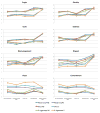Do Emotions Spark Interest in Alternative Tobacco Products?
- PMID: 28071144
- PMCID: PMC5494011
- DOI: 10.1177/1090198116683169
Do Emotions Spark Interest in Alternative Tobacco Products?
Abstract
Background: Exposure to advertisements for tobacco products and tobacco warning labels evokes emotions. This study evaluated the association of discrete positive and negative emotions with interest in alternative tobacco products.
Method: In 2013, 1,226 U.S. adult nonsmokers and current smokers viewed advertisements for moist snuff, snus, and electronic cigarettes (e-cigarettes) with various warning labels and then indicated their emotional responses in terms of anger, anxiety, sadness, guilt, disgust, discouragement, hope, and contentment. Outcomes were openness to using moist snuff, snus, and e-cigarettes in the future and interest in a free sample of each product. Data were analyzed in 2016.
Results: Hope was positively associated with openness and interest across all alternative tobacco products as was contentment for moist snuff and snus. Anger was negatively associated with openness to moist snuff and e-cigarettes, disgust negatively to moist snuff and snus, and anxiety negatively to e-cigarettes. Being a current smoker, ever trying a corresponding product, being male, and younger age were associated with greater openness to and interest in moist snuff and snus. For e-cigarettes, being a current smoker, ever trying e-cigarettes, and being female were associated with greater openness, and being a current smoker was associated with greater odds of selecting a free sample.
Conclusions: Positive emotions, particularly hope, were consistently positively associated with interest in alternative tobacco products. Hope is widely used by tobacco and e-cigarette companies to advertise their products. Antitobacco messages should aim to lower hope associated with tobacco products but increase hope for cessation or life without tobacco.
Keywords: electronic cigarettes; emotions; hope; smokeless; tobacco; tobacco products.
Conflict of interest statement
The authors declared no potential conflicts of interest with respect to the research, authorship, and/or publication of this article.
Figures


Similar articles
-
Feeling Hopeful Motivates Change: Emotional Responses to Messages Communicating Comparative Risk of Electronic Cigarettes and Combusted Cigarettes.Health Educ Behav. 2019 Jun;46(3):471-483. doi: 10.1177/1090198118825236. Epub 2019 Feb 10. Health Educ Behav. 2019. PMID: 30741001 Free PMC article. Clinical Trial.
-
Nonsmokers' responses to new warning labels on smokeless tobacco and electronic cigarettes: an experimental study.BMC Public Health. 2014 Sep 25;14:997. doi: 10.1186/1471-2458-14-997. BMC Public Health. 2014. PMID: 25253295 Free PMC article.
-
Openness to Using Non-cigarette Tobacco Products Among U.S. Young Adults.Am J Prev Med. 2016 Apr;50(4):528-534. doi: 10.1016/j.amepre.2015.08.015. Epub 2015 Nov 6. Am J Prev Med. 2016. PMID: 26549502 Free PMC article.
-
Smokeless tobacco: a gateway to smoking or a way away from smoking.Biomarkers. 2009 Jul;14 Suppl 1:85-9. doi: 10.1080/13547500902965401. Biomarkers. 2009. PMID: 19604066 Review.
-
Snuffing out cigarette sales and the smoking deaths epidemic.N Z Med J. 2007 Jun 15;120(1256):U2587. N Z Med J. 2007. PMID: 17589555 Review.
Cited by
-
Youth and Young Adult-targeted E-cigarette Warnings and Advertising Messages: An Experiment with Young Adults in the US.J Health Commun. 2022 Aug 3;27(8):574-584. doi: 10.1080/10810730.2022.2138640. Epub 2022 Nov 2. J Health Commun. 2022. PMID: 36322452 Free PMC article.
-
Feeling Hopeful Motivates Change: Emotional Responses to Messages Communicating Comparative Risk of Electronic Cigarettes and Combusted Cigarettes.Health Educ Behav. 2019 Jun;46(3):471-483. doi: 10.1177/1090198118825236. Epub 2019 Feb 10. Health Educ Behav. 2019. PMID: 30741001 Free PMC article. Clinical Trial.
-
Factual text and emotional pictures: overcoming a false dichotomy of cigarette warning labels.Tob Control. 2017 Apr 20:tobaccocontrol-2016-053563. doi: 10.1136/tobaccocontrol-2016-053563. Online ahead of print. Tob Control. 2017. PMID: 28428337 Free PMC article.
-
Targeted Versus Nontargeted Communication About Electronic Nicotine Delivery Systems in Three Smoker Groups.Int J Environ Res Public Health. 2018 Sep 21;15(10):2071. doi: 10.3390/ijerph15102071. Int J Environ Res Public Health. 2018. PMID: 30248887 Free PMC article. Clinical Trial.
-
Consumer reactions to multiple and single health warnings on static alcohol ads: A factorial survey experiment with a convenience sample of adults in Ireland.Drug Alcohol Rev. 2025 Feb;44(2):389-402. doi: 10.1111/dar.13990. Epub 2024 Dec 12. Drug Alcohol Rev. 2025. PMID: 39667723 Free PMC article.
References
-
-
15 U.S.C. §4402(b)(2) (2012).
-
-
- Anderson SJ, Pollay RW, Ling PM. Taking ad-Vantage of lax advertising regulation in the USA and Canada: Reassuring and distracting health-concerned smokers. Social science & medicine. 2006;63(8):1973–1985. - PubMed
MeSH terms
Grants and funding
LinkOut - more resources
Full Text Sources
Other Literature Sources
Medical

